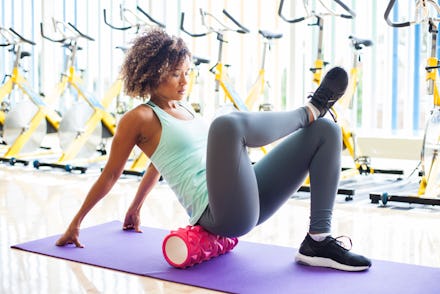Am I injured or just very sore? Here's how to tell

It seems like I’m always sore. I’m a yoga teacher and I also love to run and go to the gym, so I end up exercising at least once or twice a day. I relish the soreness that comes along with being a very physically active person. The burn in my arms and legs feels like an inner baby Hulk warming my soul, and muscle ache feels like an ironic reward for my hard work. But sometimes I wonder if I've pushed my body too far. How does one tell the difference between muscle soreness and an injury?
Feeling muscle soreness after a workout is not only normal, it can be a good sign, says Heather Milton, a clinical exercise physiologist at NYU Langone’s Sports Performance Center. “The usual muscle soreness from exercise, called DOMS or Delayed Onset Muscle Soreness, is caused by the microtrauma occurring on a microscopic level of the muscle tissue.”
Milton assures me that this isn’t bad; most times, it’s a sign that you’ve stressed the muscles enough to cause an “adaptation response.” For all intents and purposes, muscle soreness is an indicator that you're working out in a way that is changing the function and even shape of your body.
The science of gains goes like this: When you’re in beast mode, lifting and what not, “microtraumas” are created in your muscle tissue. These are little tears that allow the muscles space to grow. Think of your muscles like sheets of paper; if you tear one up and then scotch tape it back together, the sheet will be bigger than it was before you tore it up. This is a rough analogy, but it’s akin to what happens when you exercise. Pretty cool.
What’s at the core of the soreness though? “That adaptation response stimulates hormones to increase in the bloodstream, and cause the repair of the muscle tissue,” Milton says. “This process is our bodies’ way of protecting us from physical stress,” she says. These hormones are released into the bloodstream to repair the "microtraumas," and that healing can feel uncomfortable or mildly painful. The circulating hormones cause a cascade of events leading to increased breakdown of the injured tissue in order to build it back stronger. which causes inflammation, hence the soreness.
That soreness — as I mentioned before — can feel like a badge of honor for some people. No pain, no gains, right? But I’ve definitely been concerned about what the difference is between that type of soreness and the pain that indicates an injury. The processes set in motion by the microtraumas created during exercise, says Milton, peak at 24 -72 hours. There’s no easy rule to discern when you’ve gone too far, she says, but generally tolerable soreness in that timeframe is probably normal. “Discomfort that lingers more than three days, or does not dissipate despite weeks at similar intensity may be a sign that there is more to consider,” she says.
The intensity of discomfort is also a good way to tell if your workout burn is healthy or if it’s a potential injury. “It is important to differentiate between pain and soreness,” she says. “Pain is not okay, and is a sign that something is wrong. Exercising through pain for fitness is not recommended.”
Another way to gauge the difference: Consider whether the soreness is accompanied by other symptoms. “Discomfort that gets worse even with a couple days off, persists for weeks, or has characteristics of tingling, burning, numbness, or pins-and-needles should be addressed by a medical professional.”
A note to the sporadically active: If you don’t have a regular fitness routine in place, you’ll likely feel more discomfort after you work out than someone who is. Those who are not used to exercise should start slow, she says. You need to build a cardiovascular and aerobic base for yourself. “Start with 20-30 minutes of aerobic exercise anywhere from 40-75% of predicted peak heart rate,” she advises. “For strength training, start with weights that you can complete 10-12 repetitions with a moderate intensity, and build up to 2-3 sets of 10 repetitions at a hard intensity. Weight should not increase more than 5% each week.” This gradual increase will allow your body to gain strength and build tolerance at a reasonable pace.
My personal adage is that the only thing that helps ease the discomfort caused by movement is more movement and Milton says that’s generally true. “When individuals stop moving and sit on the couch when sore from a workout, that may prolong the soreness because the irritants at the muscular level are not being worked out as they would if one was continuing to move.” In this case, restorative or gentle exercise — a walk or some yoga — might work well.
She’s quick to add, however, that total rest can be crucial. “In cases where there may be a soft tissue tear due to excessive movement, that may warrant resting the affected area for a short time to avoid further injury.” Essentially, if you workout a little too hard, you’re going to have to rest a little longer.
How can we alleviate muscle soreness altogether? Milton’s final advice hit me right in my obsessively active heart. “Stay active consistently,” she says.